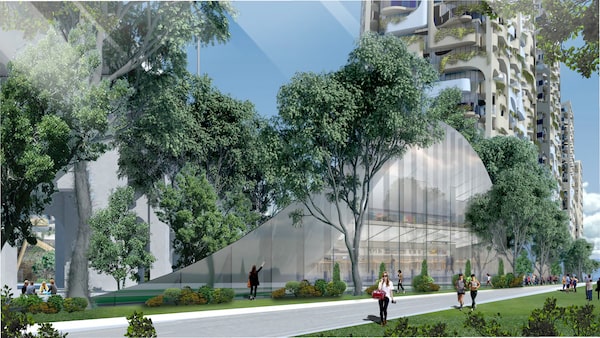
The development will be built on part of the traditional land of the Squamish Nation in the neighbourhood known as Kitsilano.Handout
A First Nations-led development proposal in the heart of Vancouver has doubled in size from its original plans to include 6,000 units of mostly rental apartments in 11 towers, a project expected to be worth billions of dollars.
The Senakw development, to be built on part of the traditional land of the Squamish Nation in the neighbourhood now known as Kitsilano, across the False Creek inlet west of downtown Vancouver, will bring a level of density and building style to the area unlike anything there now.
In April, the Squamish announced a plan for 3,000 units on the site. Squamish councillor Khelsilem told The Globe and Mail Monday that the nation’s planning group has decided to double the size and potential value. Residents of Kitsilano have traditionally opposed buildings of more than a few storeys, and community activists earlier in the year said they hoped the Squamish would consult them on the project.
“The reasonable expectation my people have is they’ve seen this whole city built up around them with very little benefit. Now they are wanting us to go this far,” said Khelsilem, who uses one name. “We as council have a responsibility to make sure the highest value is created on an asset they own.”

The planned development would be one of the largest private First Nations investment projects in the country.Handout
The City of Vancouver would have very little influence on the plan, because the land is owned by the Squamish Nation and not subject to local zoning or bylaws. Mayor Kennedy Stewart has called the housing project an opportunity to demonstrate the city’s commitment to reconciliation with Indigenous communities.
It would be one of the largest private First Nations investment projects in the country, expected by the Squamish to be in the billions of dollars, and turn the First Nation into a major developer in Vancouver’s lucrative housing market.
The 4.7-hectare project must be approved by the Squamish Nation’s approximately 3,000 members in a referendum on Dec. 10.
They’ll have to decide if they are comfortable with the idea of a 50-50 profit-sharing partnership with Vancouver developer Ian Gillespie of Westbank Corp. The Squamish would provide the land, and Westbank would do the construction.
Mr. Gillespie’s company is just finishing the Vancouver House project across the inlet, which, at 56 storeys, will be the same height as the tallest tower of Senakw.
A letter from the council to nation members says that, through a formal request for proposals and an assessment by the accounting firm Ernst & Young, “council concluded that a partnership with Westbank … will generate highest [financial value] and best-use leasing opportunities at Senakw.”

The project is relatively free from city constraints because it is on Indigenous land.Handout
The letter notes that, under regulations from the federal department Indigenous Services Canada, members’ approval is needed to allow the nation to enter a business relationship with Westbank.
Squamish Nation members are also being asked to approve the idea of having as many as 30 per cent of the units potentially sold on a leasehold basis, with a maximum 120-year lease. This is a new idea for the Squamish, who have typically done traditional rentals, such as their arrangements with a mall in West Vancouver.
In a referendum 10 years ago, the nation approved a much smaller development on the land, which is near Burrard Bridge, with only two towers. Those never went ahead because of a downturn in the housing market.
The firm Revery Architecture has designed the towers to echo elements of totem poles and reflect the mountains and sky of the North Shore, Khelsilem said.
Because it is on Indigenous land, the project is relatively free from city constraints.
As a result, planners are looking at providing parking for only 10 per cent of the apartments, far below the usual minimum, and abandoning the city’s preference for towers that sit on podiums of townhouses.

The project will be marketed to people who don’t own cars or are willing to sell them to live downtown.
Instead, the 11 towers will rise straight up. That will leave 80 per cent of the land available for publicly accessible space, some of which will be parks.
Khelselim said reducing the amount of parking so significantly will result in huge cost savings for everyone who eventually lives there, since an individual car stall would cost $80,000 to $120,000 to build.
Instead, the project will be marketed to those who don’t own cars or are willing to sell them to live downtown. The nation’s planning team is also looking at how to get a streetcar running on a former rail line that borders the Squamish land.
The team still has to negotiate with the city over water, sewer and waste-removal services, but the general idea is that the Squamish will collect taxes on all of the units, including the half owned by Westbank, and pay for services with that.
Khelselim said the project will provide a lot of opportunities for work for Squamish members in the expected six-year construction period.
Building could begin in 2021 if the project is approved in the referendum.
We have a weekly Western Canada newsletter written by our B.C. and Alberta bureau chiefs, providing a comprehensive package of the news you need to know about the region and its place in the issues facing Canada. Sign up today.
 Frances Bula
Frances Bula